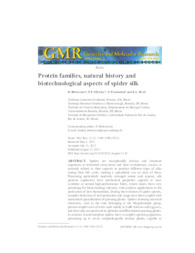Protein families, natural history and biotechnological aspects of spider silk.
Protein families, natural history and biotechnological aspects of spider silk.
Author(s): BITTENCOURT, D.; OLIVEIRA, P. F.; PROSDOCIMI, F.; RECH, E. L.
Summary: Spiders are exceptionally diverse and abundant organisms in terrestrial ecosystems and their evolutionary success is certainly related to their capacity to produce different types of silks during their life cycle, making a specialized use on each of them. Presenting particularly tandemly arranged amino acid repeats, silk proteins (spidroins) have mechanical properties superior to most synthetic or natural high-performance fibers, which makes them very promising for biotechnology industry, with putative applications in the production of new biomaterials. During the evolution of spider species, complex behaviors of web production and usage have been coupled with anatomical specialization of spinning glands. Spiders retaining ancestral characters, such as the ones belonging to the Mygalomorph group, present simpler sorts of webs used mainly to build burrows and egg sacs, and their silks are produced by globular undifferentiated spinning glands. In contrast, Araneomorphae spiders have a complex spinning apparatus, presenting up to seven morphologically distinct glands, capable to of rigidness and elasticity associated with distinct behaviors. Aiming to provide a discussion involving a number of spider silks? biological aspects, in this review we present descriptions of members from each family of spidroin identified from five spider species of the Brazilian biodiversity, and an evolutionary study of them in correlation with the anatomical specialization of glands and spider?s spinning behaviors. Due to the biotechnological importance of spider silks for the production of new biomaterials, we also discuss about the new possible technical and biomedical applications of spider silks and the current status of it.
Publication year: 2012
Types of publication: Journal article
Unit: Embrapa Western Amazon
Keywords: Biotecnologia, Spiders, Spidroins
Observation
Some of Embrapa's publications are published as ePub files. To read them, use or download one of the following free software options to your computer or mobile device. Android: Google Play Books; IOS: iBooks; Windows and Linux: Calibre.
Access other publications
Access the Agricultural Research Database (BDPA) to consult Embrapa's full library collection and records.
Visit Embrapa Bookstore to purchase books and other publications sold by Embrapa.

